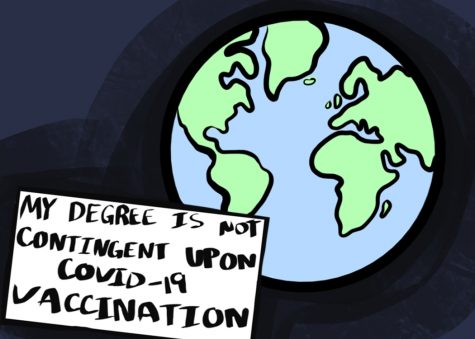WSU’s ‘Hostile Terrain 94’ Art Exhibit Shines Light on Neglected Issues
A tribute to the lives marked by toe tags
The Hostile Terrain 94 art exhibition brings awareness to the deaths of migrants on the US-Mexico border
January 26, 2023
The conversation about the danger and corruption within the U.S. immigration system is often neglected in mainstream media, allowing harmful policies to overrule basic human rights.
From Jan. 17 until March 11, the Jordan Schnitzer Museum of Art WSU is showing the Undocumented Migration Project’s Hostile Terrain 94 exhibit. The exhibit highlights the reality of the immigration system on the U.S. and Mexican border in a creative and participatory way.
The exhibit consists of over 3,400 handwritten toe tags representing migrants who have died trying to cross the Sonoran Desert of Arizona.
When I walked into the museum to look at the exhibit for myself, the Arizona map on the wall and the amount of personalized toe tags was a shock. It is one thing to hear a significant number of deaths on the news, but to see the physical tags for yourself gives a new perspective to the crisis at hand.
That was the goal of the Undocumented Migration Project, to put the issue into perspective, and they executed it perfectly. When things are put into perspective for people who have never experienced adversity, they may have a newfound sense of empathy.
Raising awareness and having meaningful discussions because of this awareness is a crucial step in enacting necessary change.
In 1994, an immigration enforcement strategy called “Prevention Through Deterrence” was implemented by the U.S. Border Patrol, intended to discourage undocumented migrants from attempting to cross the U.S. and Mexico border near the urban ports of entry.
1994 was almost thirty years ago and this policy seems about thirty years too old as well. It is so hard to believe that it is still enacted today. Putting people at risk for seeking a safer life is confusing, especially in a country that was founded upon the equality of all people and the American Dream.
As U.S. citizens, it is easy to sit back and say, “this does not directly affect me, so it is not my problem,” but for a nation with an ego as large as ours, I would expect there to be more of an effort to uphold an inclusive and empowering reputation.
The U.S. Border Patrol believed if safe methods of entry in urban areas were cut off, migrants would not want to enter the country at all due to the unsafe conditions of the alternate routes, such as the Sonoran Desert of Arizona.
However, people are not entering a country like the United States because it is “easy” to enter. If someone is escaping their home country due to unsafe circumstances, they will take whatever route will get them out of their harsh living conditions.
By limiting and cutting off safe and accessible routes, there are bleak conditions that immigrants are dying in. In the exhibit, a large majority of the mortality tags labeled the cause of death as “exposure,” which includes extreme weather conditions, sun exposure, dangerous substances and hypothermia.
This high mortality rate could have been avoided if the Prevention Through Deterrence policy was not enacted by the U.S. Border Patrol.
Living in a safe and secure location is a basic human right as well as a basic human necessity. If people are escaping for survival reasons, that should be enough of a reason to make immigration policies that have safe routes across borders.
The exhibit is unique in this way, emphasizing the importance of participation and community engagement. There are a series of workshops every few days while the exhibit is on campus that are designed to educate people on the impact of the PTD policy.
Participants in the workshop help write the information on the toe tags. This exhibit will grow with each new toe tag written into the accurate number and location of the 3,400 people that lost their lives on the Sonoran Desert of Arizona.
The emphasis on community engagement and participation from our very own students was the most inspiring part of the exhibit.
The Undocumented Immigration Project said on their website their goal with the project, to get the most participation possible, is to capture over 3,200 individual voices reading out the names of the dead who are memorialized in HT94, so they can put all of the recordings into one video. The video will then be posted online to show the loss and danger resulting from the border enforcement policies in the U.S.
All that is missing from the exhibit is more advertising. Social media information spreads very quickly and the impact that this future video along with the workshop participation could really reach a broader audience. Bringing friends to visit the works would not only support the museum but the school as well.
The exhibit has been shown nationally and globally in almost 80 locations, which should be talked about a lot more than it has been.
Promoting the Undocumented Immigration Project is the best way for their message to spread and progress to be made. Community engagement was one of the main goals of the exhibit and that is their expectation of us as WSU students and citizens of the Palouse region.















